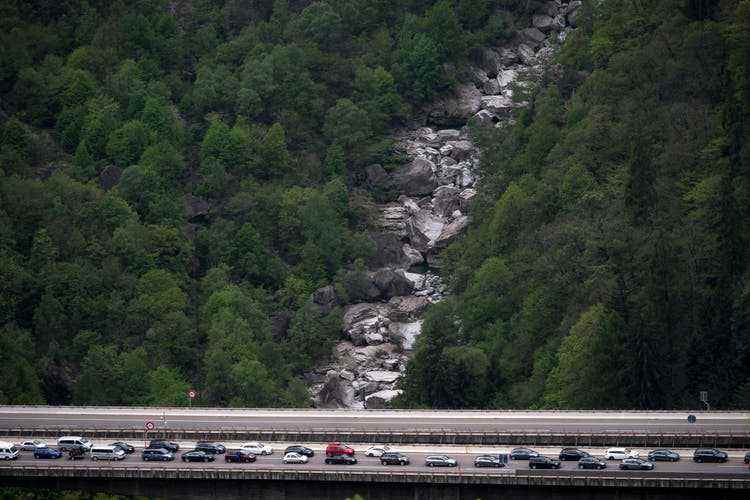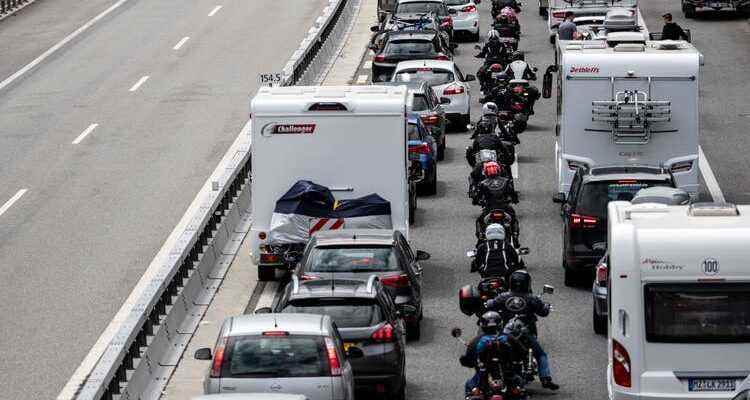This story will shorten your waiting time.
Southbound traffic jam: Gotthard traffic in Silenen in June 2019.
The people of Uri have been trying for centuries to gain power over the Gotthard, they first pierced the mountain and bridged its gorges, they are now trying to prevent rockfalls, they meter the trucks and the cars that come from all over the Alps to traverse, but on a day like today anything can happen.
It is quite possible that someone will want to turn back in the road tunnel because he wanted to go through the Schöllenen Gorge to Andermatt, but missed the exit and his navigation system in the tunnel gave the fateful signal: “Please turn around!”
It’s also possible that tourists with their wide caravans will again flee from the motorway traffic jam on the Urner Kantonsstrasse, somewhere in the Reusstal, on a narrow street, not being able to get past a post bus and thus separating the upper from the lower part of the canton.
It wouldn’t be surprising if another driver stopped in the tunnel because he didn’t fill up at the service area after all and the air conditioning and the constant stop-and-go traffic swallowed up the rest of the petrol. In addition to the electronics that hang up, an empty tank is one of the most common breakdowns in the Gotthard tunnel.
Traffic jam at the Gotthard, that’s what they say on the radio, where these Gotthard dramas are summed up and translated into numbers: 18 kilometers between Amsteg and Quinto.
Gusti Planzer should know how bad things are getting on the Gotthard these days, but he doesn’t know either. Just ten years ago, the deputy commander of the cantonal police in Uri was able to say exactly when traffic would pick up, but now he says: “The traffic jams on the Gotthard have become much more unpredictable.”
One thing is certain: even if people have become slightly more flexible in their holiday planning, even if they try to avoid traveling on less crowded days, early in the morning or late at night – in the end, traffic still backs up.
Will we be stuck in traffic forever, is it a Swiss law of nature? Is it due to a road network that is “completely at its limit”, as the director of the Federal Roads Office puts it? Or would everything be much worse if Switzerland hadn’t learned from the traffic jams of the past decades?
The perfect traffic jam
Traffic jams in Switzerland are as old as the roads. As early as 1958, the NZZ reported on the situation on the Gotthard: “The dinosaurs of the road pushed their way ‘singly’ through each bend several times, ‘sawing’, laboriously, jamming the columns in both directions and getting on our nerves (. . .). . It is evident that this once rightly celebrated stretch of road can no longer cope with today’s traffic.”
In the same year, 1958, the people voted at the ballot box for the construction of a national road network. After that, when Federal Councilor Tschudi reopened a route and praised the “solid Swiss quality work”, posters hung on the bridges: “Kölliken thanks for the autobahn.”
The autobahns were built less as trunk roads and more as bypasses – with many exits and entrances. Because Switzerland is actually a country with side roads: the topography demands it. Only two and a half percent of the roads are motorways. And the main traffic is carried by only two main axes, the west-east A 1 and the north-south A 2, which have to digest whatever comes: holiday, goods, alternative traffic, accidents, the weather.
It all came together on a February Saturday in 1995. A reporter from the Associated Press wrote that the freeways around Bern resembled “a large parking lot”. The winter sports holidays began in eight cantons and ended in Zurich and Geneva. It was snowing in the mountains and the car transport to Oberalp and Furka was closed: danger of avalanches. The motorists switched to the A1, but it was snowing there too – in the end, a total of thirty vehicles were to be involved in rear-end collisions. Chaos broke out, traffic was backed up for 53 kilometers. This is still considered a record: the perfect traffic jam.
Thomas Rohrbach, spokesman for Astra, the Federal Roads Office, says: “If it snows intensively and extensively in a short time, such a traffic jam could arise again today. You can’t clear snow before it falls.” And yet a lot has been done for decades to reduce traffic jams, at least in summer when there is no snow. The question is whether that is enough.
The security service
The Gotthard route is a good example: radar systems have been installed on the Axenstrasse, one of the sections of the A 2 where there is a risk of falling rocks. “Today, a motorway is also a measuring station,” says Astra spokesman Rohrbach, “it provides countless data”. In the event of danger, traffic lights turn red. Drivers should only have to stop in safe places.
Protection forests are maintained above the road so that the mountains cannot move too dangerously, constructions and galleries are commissioned. As long as the Axenstrasse is not a tunnel, it will remain one of the most fragile sections of the Gotthard.
The Uri police are now working with private security services to keep people on the autobahn. “In large parts of the canton we only have two roads: a motorway, a cantonal road,” says Gusti Planzer from the canton police, “and one must remain free: for local traffic, for buses, but above all as an emergency axis for the fire brigade, the first aid, the police.”
The security guards slow down traffic at the exits so that the cantonal road doesn’t become too attractive.
And in Göschenen and Airolo, in front of the tunnel portals, traffic is managed in such a way, says Astra spokesman Rohrbach, that he cannot get stuck in the tunnel: “That would quickly become dangerous.”
The Uri police do not announce how many people they are with on a day like today at the Gotthard, but Gusti Planzer says: “We are certainly on the road with an increased number.”
The Gotthard Paradox
Planzer’s people fight against powerful opponents: against the geology on the mountain, against physics and against what they call the “human factor”.
All traffic on the Gotthard depends on one number: the capacity of the road tunnel is 1,000 cars per hour in each direction. More is not possible, rather less, because people eat up additional capacity – because they are distracted, because they brake, because they cause breakdowns.
The traffic managers say that the traffic jam at the Gotthard cannot be prevented, they primarily have the appeal. Astra spokesman Rohrbach put it this way: “Stay on the Autobahn, even if the navigation system advises you otherwise, and be patient! Don’t try to make up for lost time! And in general: If you don’t have to drive on Saturday, then don’t do it!”
Kay Axhausen, Professor of Traffic Planning and Transport Systems at ETH Zurich, takes away any hope that automated cars could make traffic jams disappear. He says: “Such vehicles can use the road space more effectively, but they make driving more comfortable and cheaper – and therefore more attractive. Traffic will therefore increase, also because Switzerland is continuing to grow. The situation may not improve at all. You keep walking to stand still.”
The most effective lever against traffic jams, says Axhausen, would be a price. “Everyone knows they’re going to get stuck in traffic. Other than that, there’s no incentive not to do it.” Road tolls are the best way to clear up congestion. But politically they are unpopular: both at the Gotthard, against the holiday jam, as well as in the cities and the agglomerations, against the everyday jam.
The fight against traffic jams on the Gotthard has been going on for decades, the road is now as safe as possible, a second tunnel will open soon, there is also an emergency tunnel, there are practically no more serpentines, there are metering points – but with every measure against the traffic jam the Gotthard becomes even more attractive for traffic. And generates new traffic.
This is the Gotthard paradox. It’s almost impossible to resolve. Like the traffic jam.

